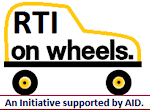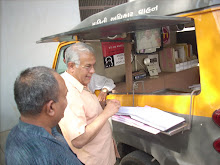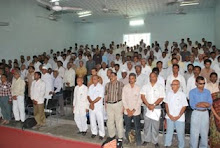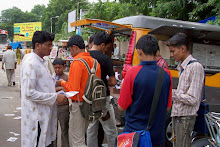Governance Now: New Delhi: Tuesday,
August 02, 2016.
It was a
four-year battle between 73-year-old Sumitra Devi and the Delhi government. Her
struggle began when the local administration abruptly stopped her monthly widow
pension in 2012. Delhi’s department of women and child development provides Rs
1,500 to every poor widow and senior citizen as monthly pension. For Sumitra, a
resident of Gol Gumbad Camp, a slum adjacent to upscale Panchsheel Park, it was
her only means of survival. The discontinuation of pension forced her to live
in penury. What followed was not only her fight to reclaim pension but also for
her right to be heard, right to life and dignity.
Clad in a
multicolour saree, Sumitra sits on a mattress outside the one-room
accommodation of her daughter’s family at the slum colony. She spends most of
the day and night lying in the less than two-foot wide gallery besides the
room. Sumitra came from her village in Bihar to Delhi “three months before the
assassination of Indira Gandhi”. She was accompanied by her elder son. (The
younger son still lives at their village. Her two daughters are married and
live with their families at this camp.)
As time would
unfold, she first lost her eldest son the bread winner of the family as he
fell from a moving train. “His father was not able to cope with the loss. He
went into depression and passed away later,” recounts Sumitra, as tears roll
down her cheeks. After her husband’s death, she was on her own. Initially she
worked as a domestic worker at a bungalow in the neighbourhood. Sometime later,
one of her daughters asked her to move in with her. Her daughter had recently
given birth and wanted someone to look after the infant. Sumitra, moreover,
regularly received her monthly pension back then which was the actual reason,
a gossipy neighbour says, why the daughter wanted her to move in.
The
government initially gave Rs 200 as monthly pension, and the amount was raised
to Rs 600 and then Rs 1,500. But something went wrong in 2012 and Sumitra
stopped receiving her monthly pension.
This
continued for 29 months, between 2012 and 2015. Meanwhile, her daughter and
son-in-law showed her the door. Eventually, she found a place to sleep at a
small temple in the same neighbourhood.
In 2012, the
women and child development department had asked all beneficiaries to provide
details of their bank accounts, in place of their postal accounts, for cash
transfer. Sumitra did not know about this change. For a year she made several
visits to the post office, but every time she was told that no money was
transferred into her account. Frustrated, one day she went to the post office
and shouted at the officials. “That’s when a senior official came out and told
me that I should get a bank account,” recalls Sumitra.
She went to a
Syndicate Bank branch nearby and opened an account. But she didn’t submit her
bank account details to the postal department as nobody told her to do so.
After waiting for a month she visited the senior official at the post office,
who now asked her to submit the bank account details to the department. He
advised her to get in touch with any women organisation working in the Gol
Gumbad area.
This is when
she came across Usha, a local member of Satark Nagarik Sangathan (SNS), who
took up her case and fought all along.
Usha and the
SNS team filed an RTI application on June 7, 2013, asking the women and child
development department why Sumitra’s pension was stopped. The public
information officer (PIO) replied: “Your pension might have been stopped
because you might not have presented an application for transfer of your
pension account from the post office to the bank.”
Unsatisfied
with the answer, Sumitra, with help from SNS, went to the first appellate and
the second appellate between July and September 2013. There was no reply. The
case was taken to the central information commission (CIC), the highest
authority for RTI. After a year of questions and answers, the CIC ruled in
favour of Sumitra on September 26, 2014. It directed the department to “pay
compensation of Rs 48,500 to the respondent … and inform her within 15 days
when payment will be made”. The commission asked the PIO to explain “why
maximum penalty cannot be imposed on him for not complying with FAA [first
appellate authority] order”. The department, however, refused to comply with
the CIC order.
In April
2015, the CIC imposed a penalty of Rs 25,000 on the PIO for non-compliance. In
June the Delhi government moved the Delhi high court seeking quashing of the
CIC orders. The court ruled in December that the government will have to pay
the entire arrears to Sumitra. It was only in February that Sumitra finally
received Rs 43,000.
Now, her
pension has been resumed. And so has
been the offer by her daughter to live with her.
The need
for grievance law
Sumitra’s
case is just one example of how citizens are forced to take the RTI route to
mount pressure on government officials to get their grievances redressed. The
unfair treatment from public officials, in the form of delay or denial of
services, has become a routine for most Indians. Reasons vary – administrative
indifference, ego tussle, commission or omission of some act against the
applicant’s interest. The internal administrative enquiries, ordered by the
head of department, in such cases are rarely conclusive.
“Those complaints
die a natural death. It is like a black hole. The complainants don’t ever get
to know what happened to their complaints,” says Anjali Bhardwaj, co-convener,
National Campaign for Peoples’ Right to Information (NCPRI), one of the civil
society organisations behind the making of the right to information law.
In 2014, the
NCPRI conducted a national study, analysing RTI applications to ascertain how
many are purely information-based queries and how many are grievance related.
The team analysed 5,000 applications. “A very large percentage of those are
related to grievance redress people not getting ration and pension, among
others,” explains Bhardwaj.
In the
absence of a grievance law, people are forced to file RTI applications. They
actually do not seek any information through RTI, but seek answers and
resolutions to their queries.
And what kind
of questions people ask in their RTI applications in the absence of a grievance
redressal law? “One, people want to know how much ration or subsidy they were
supposed to get, who was supposed to deliver, what action would be taken
against the officials if they file a complaint. The applicants want to seek a
response to their complaints,” says Bhardwaj.
Her team
found that 16 percent were “literally grievances”. A major chunk, about 50 to
60 percent, was indirect grievance redress. “An example of such an application
would be ‘I have not got my pension. Who is responsible for it?’ This is why,
in many ways, we call the grievance redressal legislation RTI part two,” adds
Bhardwaj.
Four to six
million RTI applications are filed every year. This is the highest number
globally – reaffirming lack of transparency and accountability in governance.
Understanding
the grievance redressal bill
What is a
Citizens Charter?
A document
declaring the functioning, obligations, duties, commitments of a public
authority for providing goods and services effectively and efficiently with
acceptable levels of standards, time limits and designation of public servants
for delivery and grievance redress.
How do you
define a complaint?
It means a
complaint filed by a citizen regarding any grievance relating to, or arising
out of, any failure in the delivery of goods or rendering of service pursuant
to the citizens charter, or in the functioning of a public authority, or any
violation of any law, policy programme, order or scheme but does not include
grievance relating to the service matters of a public servant whether serving
or retired.
What is the
procedure to file a complaint as defined under the grievance bill, 2011?
The applicant
has to file a complaint to the grievance redress officer of the respective
department. The complaint has to be acknowledged within two days of receiving
and it has to be remedied within 30 days. Every complaint which has not been
redressed within 30 days will be forwarded to a higher designated authority,
with details of complainant, nature of complaint, and reasons for non-redressal
of complaints.
What is
the procedure to go for an appeal?
The
complainant can approach the designated authority within 30 days of the expiry
of duration of application disposal at the GRO level. The authority has to
respond within 30 days. If the applicant is not satisfied, she or he can go to
the state grievance redress commission within 30 days of the expiry of duration
at the first appellate level. The commission will have to respond within 60
days. If the applicant still feels unsatisfied, he can file an application to
central grievance commission within 30 days of expiry of duration at the state
grievance commission level. The central commission will have to respond within
60 days.
Will
penalty be imposed on erring officials?
The designate
authority, state public grievance redressal commission or central public
grievance redressal commission may impose a lump sum penalty which may extend
up to '50,000, against designated official responsible for delivery of goods
and services. That amount could be given to the applicant as compensation if
the appellate authority may deem fit.
What is
the composition of the public grievance commission at the state and central
level and how will the chief commissioner be appointed at both levels?
State and
central commissions will have a chief commissioner. The number of commissioners
would not exceed 10 and out of this one each shall represent scheduled caste,
scheduled tribe and women. The chief public grievance redress commissioner and
central public grievance redress commissioners shall be appointed by the
president of India on the recommendation of a committee consisting of a) the
PM, the chairperson of the committee; b) the leader of opposition in the Lok
Sabha; and c) a sitting judge of the supreme court to be nominated by the chief
justice. The committee at the state level will have similar composition for the
appointment of chief commissioner and commissioners.
“In most
countries it [the transparency law] is being used by the journalists and the
elite. Here it is being used by the poor, marginalised, because they are most
dependent on services and the services don’t come to them,” she says. “The
grievance redressal mechanism doesn’t work. When they file complaints nothing
happens. So they file an RTI.”
A brief
history
The first
step towards fixing bureaucratic accountability in service delivery was taken
with the introduction of the Citizens Charter in 1997. It was, however,
voluntary in nature. In order to improve public service delivery, a service
excellence model called ‘Sevottam’ was initiated in 2005 by the prime
minister’s office (PMO) to give a new thrust to the implementation of the
Charter. Two years later, the government introduced the Centralised Public
Grievance Redress and Monitoring System (CPGRAMS), a web-based portal for
lodging complaints. These initiatives, nevertheless, had limited success, in
dealing with wide-scale corruption in the lower levels of bureaucracy.
The 2011
anti-corruption movement, led by social activist Anna Hazare and Arvind
Kejriwal, mobilised people for a strong legislation against corruption. It was
then that civil society activists demanded two separate laws: one to set up a
Lokpal or ombudsman to curb big-ticket corruption and the other to deal with
public grievances arising from lower level corruption.
The
department of personnel and training (DoPT) drafted the first version of ‘The
Right of Citizens for Time Bound Delivery of Goods and Services and Redressal
of their Grievances Bill, 2011’ and introduced it in the Lok Sabha on December
20, 2011. The bill was referred to a parliamentary standing committee headed by
Shantaram Naik on January 13, 2012, that submitted its report on August 28,
2012.
In one of its
most significant recommendations, the committee supported a comprehensive
definition of ‘complaint’ not just limited to services mentioned in the
Citizens Charter but also violation of any law, policy, scheme and order, among
others, by a public authority – as stated in the 2011 version of the bill.
The report
said, “The committee is of the firm opinion that issues related to violation of
law, policy, scheme, etc. are vital and the same cannot be kept outside the
purview of the grievance redress mechanism.”
It means if
officials at a government school, hospital, police station or any other
government body deny services to people, they can be held accountable for their
action/inaction.
“The
parliamentary committee, to our joy, gave a more maximalist position than we
did. Politicians across party lines supported the legislation,” says Bhardwaj
of the NCPRI.
In 2011 there
was a sense of house resolution when the whole movement for Lokpal was at its
peak. “The MPs said they were taking a resolution to pass a Lokpal and a
grievance redressal law.”
During the
debate on Lokpal in both the houses in December 2013, BJP leaders including
Arun Jaitley, Sushma Swaraj and Ravi Shankar Prasad unanimously voiced their
support to the grievance redressal bill. “There is no political dispute on this
law. It will enhance the quality of administration. That’s why it should be
soon enlisted on Lok Sabha’s agenda and then brought to this house to be
passed,” Arun Jaitley said in the Rajya Sabha on December 17, 2013.
The noble
intentions apart, the bill could not be passed due to parliamentary
disruptions, and it lapsed with the dissolution of Lok Sabha in 2014.
Apparently,
the new government was very much alive to the need for a grievance redressal
legislation. A PMO communication sent to the DoPT and department of
administrative reforms and public grievances, dated June 24, 2014, highlights
two “immediate thrust areas” of the government. One was passing of Citizens
Grievances Bill and second was amendments in the Prevention of Corruption Act.
However, there was not much progress in parliament in actually legislating the
laws.
Between May
2014 and March 2016, at least eight questions were posed to the government
about the grievance redressal bill in the two houses by MPs including those
from the BJP. In response to the questions in parliament in February and March
2015, Jitendra Singh, minister of state for personnel and training, reiterated,
“The government is committed to bringing in a legislation for ensuring
effective redressal of grievances of citizens related to non-delivery of
entitled goods and services by the government. However, at this stage, no
realistic time frame can be indicated for introduction of such a bill in the
parliament.”
In March
2016, out of the blue, the government suddenly changed its tune in parliament.
The proposed law was dropped and in its place came a proposal of a mere scheme.
Minister Jitendra Singh said that the government is concerned about the
grievance redress and so it is bringing a scheme. “For this purpose, a scheme
knows as Delivery of Services and Grievances Redressal Scheme, 2015 has been
prepared,” the minister told parliament. A scheme, of course, can be changed by
the government. It is not a law which gives citizens a justiciable right. With
‘right’ one can go to court.
According to
an official working with the department of administrative reforms and public
grievances, the government will introduce a grievance redressal scheme before
the year-end. Asked about the scope of complaint defined under the proposed
scheme, the official said that the complaint will be confined to duties and
actions carried out by public officials under the Citizens Charter of the
respective department. The scope of a complaint doesn’t go beyond a Citizens
Charter – which is in contrast to the comprehensive definition of a complaint
as stated under the grievance redressal bill 2011.
A panacea?
According to
measures proposed in the draft bill, the process of getting a grievance
redressed was to be made easy. Complaints automatically get escalated at higher
levels at the end of a specified time, that is, 15 days. It is not incumbent on
the applicant to take the application to higher levels in case a public
authority fails to provide redressal. The automatic escalation feature has not
been provided under the RTI.
“As laws go,
this was fairly drafted. It had a time-bound system and system of penalty if
grievance redress officer failed to provide service in time. The penalty amount
was kept at Rs 50,000,” says Bhardwaj. The complaints could be done by SMS or
helpline number. So it was that easy to file a complaint. “For us it would have
been as significant a law as RTI is,” she adds.
But Yamini
Aiyar, a senior fellow at the Centre for Policy Research, and director of its
Accountability Initiative, says that we need to move beyond legislation. Had
law been the solution to every problem, all government schemes would have been
implemented in a better manner.
To make state
responsive, there is a need for a much more detailed and in-depth approach
towards administrative reforms, she adds. “While I appreciate the need for a
grievance law, it will not yield desired outcome in the absence of a wider
administrative reform.”
Chakshu Roy,
head of outreach, PRS Legislative Research, though believes that a law would
empower people, but it has to be backed by “strong willingness” from the government.
“The government needs to carry out massive sensitisation campaigns to generate
awareness. Having a law is simply the first step,” he says.














































































